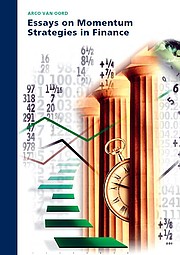Essays on Momentum Strategies in Finance Defended on Thursday, 12 May 2016
This thesis discusses several aspects and possible improvements of equity momentum strategies in finance. Equity momentum is the phenomenon that stocks that have recently outperformed continue to outperform, while underperformers will continue to underperform. Equity strategies that exploit this phenomenon by buying the recent outperformers and short-selling the recent underperformers have proven to be profitable for investors. In his Nobel prize lecture in 2013 Eugene Fama referred to this performance of the momentum strategy as being the biggest challenge for the efficient market hypothesis.
Nevertheless, equity momentum is also known for its crash risk, wiping out years of average positive returns in just a few months, and the fact that its risk and returns vary over time. In this thesis different hedging strategies are applied to reduce momentum’s crash risk and time varying exposures without reducing its positive average returns. Furthermore, different recent improvements of momentum are combined in a mean-variance optimization set-up. Optimization also reduces momentum’s crash risk and its time varying exposures. Moreover it improves momentum’s Sharpe ratio for moderate transaction costs.
Finally, this thesis addresses momentum’s time varying risks and returns in a different way. A Bayesian latent factor model where the number of latent factors is allowed to vary over time is derived. Using the predictive likelihood approach this model is then applied to a residual industry momentum strategy. In turbulent times, like the crisis that started in 2008, the Bayesian latent factor model performs well in terms of risk and return characteristics.
Keywords
Momentum, Hedging, Time-varying risks, Mean-variance optimization, Factor model, Bayesian latent factor model










